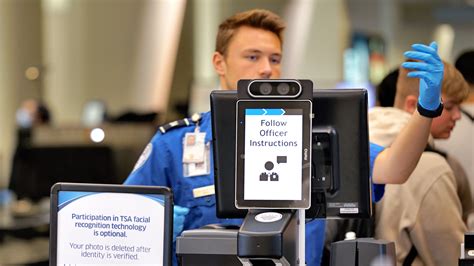
Plugging your phone into a public USB charging station at the airport could expose your data to hackers, warns the Transportation Security Administration (TSA), as they caution travelers about the dangers of “juice jacking.” Cybercriminals can load malware onto these public ports, potentially compromising your device and stealing personal information.
TSA Warns: “Juice Jacking” Poses Cybersecurity Threat at Airports
The Transportation Security Administration (TSA) has issued a warning to travelers about the growing threat of “juice jacking,” a cyberattack that exploits public USB charging ports to compromise electronic devices. According to the TSA, hackers can load malware onto these seemingly innocuous charging stations, potentially gaining access to sensitive data stored on smartphones, tablets, and other portable devices. This warning highlights the need for heightened vigilance and the adoption of safer charging practices while traveling.
“Plugging into a public USB port is kind of like finding a toothbrush on the side of the road and deciding to stick it in your mouth. You have no idea where that thing has been,” said Drew Paik, a security expert at Authentic8, in a statement that underscores the potential risks involved.
The TSA’s warning aligns with earlier alerts from the Federal Bureau of Investigation (FBI) and other cybersecurity experts who have long cautioned against the use of public USB charging stations. These stations, often found in airports, hotels, and other public spaces, are convenient for travelers needing to recharge their devices, but they can also serve as conduits for malicious software.
How “Juice Jacking” Works
“Juice jacking” involves hackers installing malware on public USB charging ports or cables. When a user connects their device to an infected port, the malware can silently install itself onto the device. This malware can then be used to steal data, such as login credentials, financial information, personal contacts, photos, and other sensitive data. In some cases, the malware can even lock the user out of their device and demand a ransom for its release.
The process is often seamless and undetectable to the average user. The device appears to be charging normally, while in the background, the malware is quietly compromising the device’s security. This makes “juice jacking” a particularly insidious form of cyberattack.
The Risks of Using Public USB Charging Stations
The risks associated with using public USB charging stations are significant. Once a device is infected with malware, the consequences can be far-reaching. Hackers can use the stolen data to commit identity theft, financial fraud, or other malicious activities. They can also use the compromised device as a gateway to access other devices on the same network, potentially infecting a larger number of users.
Moreover, businesses and organizations whose employees use public USB charging stations are also at risk. If an employee’s device is compromised, hackers can potentially gain access to sensitive corporate data, leading to data breaches and financial losses.
Safer Charging Alternatives
To protect themselves from “juice jacking,” the TSA recommends that travelers adopt safer charging practices. Some of the recommended alternatives include:
- Using AC Wall Outlets: The safest way to charge a device is to use an AC wall outlet with your own charging cable and adapter. This eliminates the risk of connecting to a compromised USB port.
- Carrying a Portable Charger: Portable chargers, also known as power banks, provide a convenient and secure way to charge devices on the go. These devices can be charged at home and then used to recharge devices without the need for a USB port.
- Using a USB Data Blocker: A USB data blocker, also known as a “charge-only” adapter, is a small device that sits between the USB cable and the charging port. It blocks the data pins in the USB connection, allowing only power to flow through, preventing the transfer of data and protecting the device from malware.
- Investing in a Secure USB Cable: Some USB cables are designed with a built-in data blocker, providing an added layer of security. These cables can be used with any USB charging port without the risk of data theft.
- Being Vigilant: Always inspect public USB charging ports for signs of tampering or damage. If a port looks suspicious, avoid using it.
FBI Warnings and Cybersecurity Expert Advice
The TSA’s warning echoes previous alerts from the FBI and other cybersecurity experts. In April 2023, the FBI issued a similar warning, urging travelers to avoid using public USB charging stations. The FBI recommended using personal chargers and AC wall outlets whenever possible.
Cybersecurity experts have also emphasized the importance of keeping devices updated with the latest security patches. These patches often include fixes for vulnerabilities that hackers can exploit to install malware. Additionally, experts recommend using a strong password or biometric authentication to protect devices from unauthorized access.
Background on USB Security Vulnerabilities
The vulnerability of USB ports to cyberattacks has been a known issue for several years. In 2014, researchers demonstrated how a malicious USB device could be used to take control of a computer. This demonstration highlighted the potential for USB ports to be used as a vector for cyberattacks.
Since then, numerous other vulnerabilities have been discovered in USB devices and protocols. These vulnerabilities can be exploited by hackers to install malware, steal data, or even damage devices. As a result, cybersecurity experts have consistently warned against the use of untrusted USB devices and charging ports.
“Juice Jacking” in the Context of Broader Cybersecurity Threats
“Juice jacking” is just one example of the many cybersecurity threats that travelers face. Other common threats include:
- Public Wi-Fi Hacking: Public Wi-Fi networks are often unsecured, making them vulnerable to hacking. Hackers can intercept data transmitted over these networks, potentially stealing login credentials, financial information, and other sensitive data.
- Phishing Attacks: Phishing attacks involve hackers sending fraudulent emails or text messages that appear to be from legitimate sources. These messages often contain links to fake websites that are designed to steal login credentials or other personal information.
- Malware Infections: Malware can be spread through a variety of channels, including email attachments, malicious websites, and infected USB drives. Once installed on a device, malware can be used to steal data, damage files, or even take control of the device.
Staying Safe While Traveling
To stay safe while traveling, it is important to be aware of these cybersecurity threats and take steps to protect yourself. Some of the recommended precautions include:
- Using a Virtual Private Network (VPN): A VPN encrypts your internet traffic, making it more difficult for hackers to intercept your data. This is especially important when using public Wi-Fi networks.
- Being Cautious of Suspicious Emails and Text Messages: Avoid clicking on links or opening attachments in emails or text messages from unknown or untrusted sources.
- Using Strong Passwords: Use strong, unique passwords for all of your online accounts. Avoid using the same password for multiple accounts.
- Enabling Two-Factor Authentication: Two-factor authentication adds an extra layer of security to your online accounts by requiring you to enter a code from your phone or another device in addition to your password.
- Keeping Your Devices Updated: Install the latest security patches and updates for your operating system and applications.
- Backing Up Your Data: Regularly back up your data to a secure location. This will protect you from data loss in the event of a malware infection or other security incident.
- Installing a Mobile Security App: A mobile security app can help protect your device from malware, phishing attacks, and other cybersecurity threats.
The Future of USB Security
The threat of “juice jacking” and other USB-related cyberattacks is likely to persist as long as USB ports remain a common charging method. However, there are ongoing efforts to improve USB security.
One approach is to develop more secure USB protocols that incorporate built-in authentication and encryption. Another approach is to develop hardware-based security solutions that can detect and block malicious USB devices.
In the meantime, it is important for travelers to be aware of the risks of using public USB charging stations and to adopt safer charging practices. By taking these precautions, travelers can protect themselves from “juice jacking” and other cybersecurity threats.
The Importance of Public Awareness and Education
The TSA’s warning underscores the importance of public awareness and education about cybersecurity threats. Many travelers are unaware of the risks associated with using public USB charging stations. By raising awareness of these risks, the TSA can help travelers make more informed decisions about how to charge their devices while traveling.
In addition to issuing warnings, the TSA can also provide educational materials and resources to help travelers learn more about cybersecurity best practices. This can include tips on how to choose strong passwords, how to identify phishing emails, and how to protect their devices from malware.
Industry Response and Security Measures
In response to the growing threat of “juice jacking,” some airports and other public spaces have begun to remove public USB charging stations. Others have implemented security measures to protect users from malicious attacks. These measures include:
- Installing Data Blockers: Some airports have installed data blockers on their USB charging ports to prevent the transfer of data. This ensures that only power can flow through the port, protecting users from malware.
- Monitoring USB Ports: Some airports are monitoring their USB charging ports for suspicious activity. This allows them to detect and respond to potential cyberattacks quickly.
- Providing Alternative Charging Options: Some airports are providing alternative charging options, such as AC wall outlets and wireless charging stations, to reduce the reliance on USB charging ports.
Legal Ramifications and Law Enforcement Efforts
“Juice jacking” is a form of cybercrime and can have legal ramifications for those who engage in it. Depending on the severity of the attack and the amount of damage caused, perpetrators can face criminal charges and civil lawsuits.
Law enforcement agencies, such as the FBI, are actively investigating “juice jacking” incidents and working to bring perpetrators to justice. However, prosecuting these cases can be challenging, as it can be difficult to identify and track down the hackers responsible.
Conclusion
The TSA’s warning about “juice jacking” serves as a timely reminder of the cybersecurity threats that travelers face. By being aware of these threats and taking steps to protect themselves, travelers can significantly reduce their risk of becoming victims of cybercrime. As technology evolves, it is crucial to stay informed and adapt security practices accordingly to safeguard personal and sensitive information. The best way to charge your devices when traveling is to use an AC wall outlet with your own cable and adapter, or to bring a portable charger.
Frequently Asked Questions (FAQ)
1. What is “juice jacking”?
“Juice jacking” is a type of cyberattack where hackers load malware onto public USB charging ports. When you plug your device into an infected port, the malware can silently install itself on your device, potentially stealing data or compromising its security.
2. Where are public USB charging stations typically found?
These stations are commonly found in public places like airports, hotels, train stations, and shopping malls.
3. What types of data can hackers steal through “juice jacking”?
Hackers can potentially steal a wide range of data, including login credentials, financial information, personal contacts, photos, and other sensitive data stored on your device. They can also potentially lock you out of your device and demand a ransom.
4. How can I protect myself from “juice jacking”?
To protect yourself, use AC wall outlets with your own charging cable and adapter, carry a portable charger, use a USB data blocker (“charge-only” adapter), or invest in a secure USB cable designed with a built-in data blocker.
5. What should I do if I suspect my device has been “juice jacked”?
If you suspect your device has been compromised, immediately disconnect it from the USB port. Then, run a full scan with a reputable antivirus or anti-malware program. Change your passwords for important accounts, monitor your financial accounts for suspicious activity, and consider consulting with a cybersecurity professional. Factory resetting your device may also be necessary.









